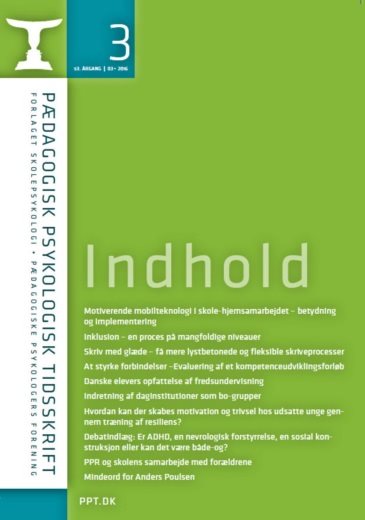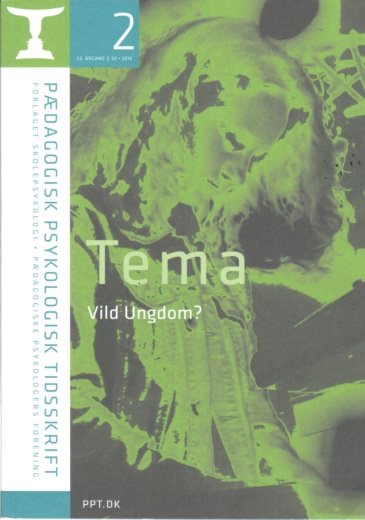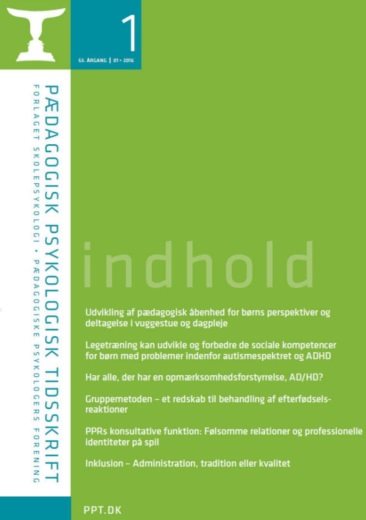Beskrivelse
Abstracts ppt 3/2016:
Lise Hostrup Sønnichsen: Motivational mobile technology in home-school collaboration – significance and implementation. Pædagogisk Psykologisk Tidsskrift, 2016, Vol 53, 3, 3-13. This article focuses on how the use of a handicap compensating application, Show My Day (SMD), can make a qualitative difference in the collaboration between home and school concerning students with ASD and similar difficulties. In addition, the article, within an implementation perspective, provides a proposal of the preconditions for this by pointing to potentials, attention points and dilemmas. Using Wenger’s theory on community of practice’s procedural structure with a special focus on the terms reification, participation and negotiation of meaning, the article argues how the use of the app can potentially contribute to a more equal collaboration.
Hanne Nissen and Christina Hoffmann-Christensen: Inclusion – a process on multiple levels. Pædagogisk Psykologisk Tidsskrift, 2016, Vol 53, 3, 14-20. In our paper, we argue that for inclusion to work, it no longer must be seen only as a method in our primary school system, but should be viewed in a broader, social view. We define inclusion as a dynamic, continuous and flexible process, which is dependent on a certain flexibility in and between the systems and the people, who in their own separate ways might influence inclusion in primary schools. Through a case, we illustrate some of the multiple factors that influence the possibilities for inclusion. Furthermore, the case exemplifies some of the contexts and interpersonal positions the teachers have to navigate in during their daily work with inclusion. We argue that the systemic mentality, prevalent in our primary school system today, not only should apply to the contexts and relationships of the students, but also to those of the teachers. The opportunities for teachers to include students are to a high degree defined by the contexts and relationships that influence them. At the same time, we argue that teachers, by understanding the factors that affect inclusion, can go from a feeling of powerlessness to seeing new possibilities, and we propose how psychologists who specialize in pedagogical psychological counselling can support the teachers in this process.
Charlotte Wegener: Write with joy – learn more pleasurable and flexible writing processes. Pædagogisk Psykologisk Tidsskrift, 2016, Vol 53, 3, 21-28. Like never before, there are requirements to communicate and publish our knowledge. In most academic studies and in many academic jobs, texts are the most important 108 Pædagogisk Psykologisk Tidsskrift medium, though which we express ourselves to convey what we ‘know’ and ‘found’. At the same time, we convey something about who we ‘are’. Through writing, we show that we manage the knowledge and conventions valued in a given practice. The more successful in doing so, the fuller participants we become. When we fail, we may doubt if we belong to this practice at all. Writing is both knowledge production and identity work, and therefore step-by-step guides to academic writing are often not enough. The article presents three metaphors for academic writing processes; The toolbox, The building materials and The building. The toolbox relates to how we write (practice and linguistics), The building materials relate to what we write about (content), and The building relates to why we write (vision). Individually and together, the three metaphors contribute to more flexible writing processes that are not entirely structured and linear, yet not random and chaotic either. The
three metaphors are expanded and illustrated with stories and writing ideas in the book ‘Writing with joy. A guide to academic writing’.
Lene Kirstine Gundersen and Jørn Nielsen: To strengthen relations – An evaluation of a competency development course. Pædagogisk Psykologisk Tidsskrift, 2016, Vol 53, 3, 29-52. In this article, the effects of a competency development course, which Vordingborg Municipality has launched for supporting functions (PPR-psychologists, inclusion-supervisors, etc.), will be evaluated. The
course was created on the basis of a paradox: On one hand, teachers and pedagogues have underscored in an evaluation-report “Focus on State School” [Fokus på folkeskolen] that they feel challenged in accommodating the political goals concerning that all children and adolescents must thrive, develop their potential and be a part of communities. They especially call for more practice-related support and supervision from the supporting functions. On the other hand, a group of supporting functions report not being contacted or used by the schools and institutions. To try and overcome this paradox, Vordingborg Municipality launched a competency development course for the supporting functions with a view to qualifying their competency in supporting and helping teachers and pedagogues to create inclusive, developing learning-environments for all children. This article is an evaluation of what effects this course has had on teachers and pedagogues.
Peter Berliner & Ann-Jeanett Foldager Bøndergaard: Danish students’ perception of peace education. Pædagogisk Psykologisk Tidsskrift, 2016, Vol 53, 3, 53-62. The paper presents the results of a study of Danish school students (in 6th grade) on whether or not they believed that they had received peace education. Furthermore, we asked them if they would like more peace education. The study is a pilot study in 4 schools, in 4 parts of Denmark. The total number of students in the study is 212: 108 girls and 104 boys. The majority of students responded that they did not believe that they had received peace education. Similarly, the majority Nr. 3 – 2016 109 expressed that they would like to have, or to have more, peace education. A large number of the students responded that they do not speak with anyone about peace neither in school nor in the family. Although this study only includes a small number of students, we still find these results puzzling as Denmark has remarkably high rankings on international scales that measure the cultures of peace, trust, democracy and equality in society. In the discussion we present an explanation of this
discrepancy, because we argue that there is a lot of peace education in schools, but it is not labelled as such to the students. Organizing a safe learning environment is peace education, but may not be labelled as such. Also, there may be teaching about peace building processes in social science and art, but again without being labelled as such. We recommend that it could be made more clear to the children when they receive peace education as that will give a more coherent understanding of peace building globally, in society, and in the local context of the school and the classroom.
Ditte Winther-Lindqvist: Designing day-care environments as home-groups. Pædagogisk Psykologisk Tidsskrift, 2016, Vol 53, 3, 63-74. This paper proposes designing day-care environments according to a new unity of organization that we call a home-group. Based on a socio-cultural end ecological theoretical framework, we work with a design that encompasses and supports children’s development through interrelated zones in the pedagogical environment: The zone of free movement, the zone of promoted action, the zone of proximal development and the zone of intimacy. Following an analysis of current designs of and practice in Danish day-care, we identified some challenges that the new home-group could encounter. The zones are used as heuristic devices for organizing and designing the home-group consisting of rich and varied areas for meaningful activities, dialogue and play, both inside and outside. A sketch of this design is presented and proposed for inspiration when building or re-shaping existing day-care environments.
Line Spicker: How can motivation and well-being be fostered in vulnerable young people through resilience training? Pædagogisk Psykologisk Tidsskrift, 2016, Vol 53, 3, 75-84. This study tests the effectiveness of a resilience training program (RTP) for adolescent students from a low socioeconomic group, who exhibited elevated levels of behavioral problems. The resilience training program is primarily based on theories and methods from the field of positive psychology. The resilience training program is a seven-session at-school intervention therapy. Both quantitative
and qualitative research has been used to measure the effects of the resilience training program. Conclusively, the resilience-training program has shown some level of effect concerning the progression of resilience and behavior problems among the participants. It also shows the importance of providing af basis of a close relationship to the student concerning guidance in realtion to self-criticism and self-awarness.
Contribution to a debate: Luuk L. Westerhof (Norge): Is ADHD a neurological disorder, a social structure or it can be both? Pædagogisk Psykologisk Tidsskrift, 2016, Vol 53, 3, 85-95. ADHD has become one of the major childhood diseases in our society. The use of medication in combating the disorder has assumed enormous proportions. In her article “From hyperactive to central stimulated – An Essay on child doping” in Samtiden nr. 3/2011: Fra hyperaktiv til sentralstimulert – Et essay om barnedoping, Doctor Charlotte Lunde writes that sales of ADHD-medication in Norway has risen from NOK 4 million to 184 million during the last eleven years. More than 17,500 children and adolescents are now on ADHD medication. What professionals, in my opinion, have lost sight of, is that children with a high degree of activity and lack of impulse control, often live under difficult life circumstances and adjacent challenges. High level of activity, attention deficit and lack of impulse control are not medical problems- they are more in congruence with normal painful challenges in life! ADHD as a diagnosis may be due to flawed judgement; when
ADHD is characterized as a disease without examining and including the child’s life circumstances. This gives a far too one-sided diagnoses! Due to a lack of focus on entirety, there is a risk of renaming usual life challenges as inherent deviation and illness in the child. The question arises; is ADHD a neurological disorder, a social construction or both?
Henning W. Nielsen and Bjarne Nielsen: PPR and the school’s collaboration with parents. Pædagogisk Psykologisk Tidsskrift, 2016, Vol 53, 3, 95-105. In this article, we first very briefly mention the types of difficulties parents experience based on the mentioned letter column questions. Then a brief comparison is made with descriptions from the 2015 annual report of the Board of Appeal. Then we also mention which responsible parties must assume responsibility for the school professional being able to look to prevent conflicts with parents and/or work qualified
with the solutions when they may arise. Then we describe in a more general way the school’s important collaboration with parents in order to ensure their active involvement in the responsibility to develop qualified teaching for all students. With a background in this, we point to PPR’s options to help qualify and professionalize teachers’ and schools’ collaboration with parents, so the fewest possible conflicts occur.


